Preparing for Lambing
Lambing Supplies
- Camp stool
- Makes theMore about
working newborn lambs ► whole experience of working lambs more pleasant.
- Flashlight or lantern and extra batteries
- News Flash: Lambs do not always cooperate in arriving in the
warmth of mid-day.
- Gloves
- We used to use latex or vinyl gloves, but the nitrile gloves are way better.
We actually don't work the lambs while wearing these gloves, preferring the
sensitivity of bare fingers. We use the gloves when we discover a fresh wet lamb
in a situation where it seems the right thing to put mother and her lamb in a jug
More
about jugging ►
right away, before she has licked it dry and gotten it to nurse. We use the gloves
to keep our scent off the lamb until the two are bonded. Once they are safely
in the jug we leave them alone until the lamb has nursed.
- Lamb ear tags and applicator
-
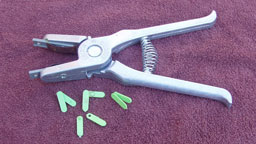 If you are expecting more than two or three lambs, and you want to be sure of their
parentage, there is no substitute for an ear tag. Unfortunately, commonly-available
tags are way too heavy for Soay lamb ears. Our long-time source of appropriate tags—Dalton—no longer carries them, so try for rabbit tags or anything you can find that is really small.
If you are expecting more than two or three lambs, and you want to be sure of their
parentage, there is no substitute for an ear tag. Unfortunately, commonly-available
tags are way too heavy for Soay lamb ears. Our long-time source of appropriate tags—Dalton—no longer carries them, so try for rabbit tags or anything you can find that is really small.
- Thermometer and lubricant
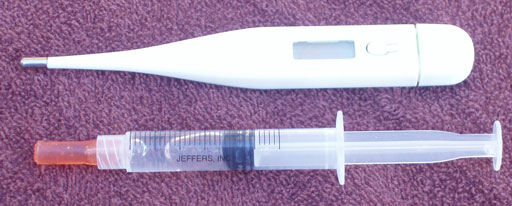
- The now-common digital thermometer available from drug stores is
all you need. Your family will be happier if you don't use the one from the
bathroom.
- It is a good idea to use KY jelly or a similar product as a lubricant when
taking the lamb's temperature. Smear a little on the tip of the thermometer or on
the lamb's back end to make things go more smoothly. We dedicate a 3cc syringe
(without needle) for this, as shown in the photo. The pink tip is a short piece of
1/8 inch micro fuel line, available from your hardware store. It fits nicely on
the syringe tip. Hint: don't try to fill the syringe by sucking. Rather, pull out
the plunger and fill from the open end.
- BO-SE and Vitamins A&D

- BO-SE is the brand name of a solution of vitamin E and Selenium. It is a
prescription product (we're not sure why) that you can get from your vet. It is
important in our selenium-deficient area, but check with your vet or extension
agent.
- Vitamin A&D solution does not need a prescription, and you can get
it from your feed store or via catalog . The bottle we got from our vet contains
500,000 IU/cc Vitamin A and 75,000 IU/cc vitamin D3. Jeffers has it in their catalog.
- Syringes and needles
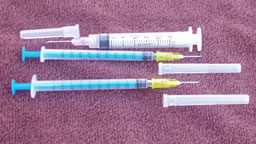
- We use 1cc “tuberculin” syringes for both lamb injections (0.25cc)
and 3cc syringes for the ewe's shot (1cc). You could use a 1cc syringe for the
ewe, but we find it clumsy to deal with a 1cc syringe all-the-way full. The 3cc
syringes should be of the luer-lock type to keep the needle from popping
off, as the BO-SE solution is quite viscous, especially when cold. Unfortunately,
the 1cc syringes we use for lambs seem to be available only in the
luer-slip design, so it is possible for the needle to pop off if you
deliver the dose too quickly.
- 20 gauge needles are the best compromise. 18g is too large, especially for
lambs. 22g needles are too thin for the viscous BO-SE or A&D solutions. Try to
find 1/2" or 5/8" lengths. Longer ones will work, but a shorter length makes it
easier to avoid "punching through" and "blowing the dose," particularly with a
wriggly lamb.
- Portable scale and lamb sling
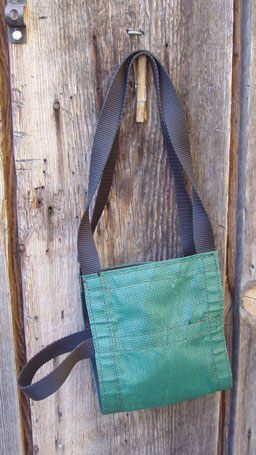
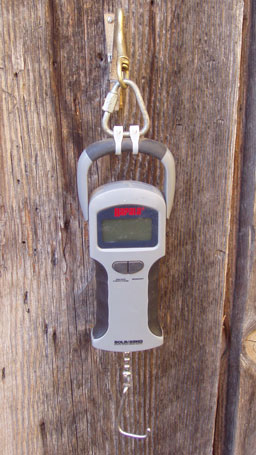
- These simple digital scales are available from sheep supply companies as well
as from sporting goods companies (they are sold as fish scales). The lamb sling is
a real help, as it's much easier to use than a bucket. Available from Premier and Pipestone. You may get funny looks if
you ask for a lamb sling from the bait and tackle shop.
- Vaseline
- Smear a gob around the lamb's rear end, and on the underside of his tail. This
will help keep the newborn's sticky feces from forming a hard clod that can
literally plug the lamb up. If this happens – the lamb is said to be
“pinned” – you must remove the clump of feces
to save the lamb. It is a truly yucky undertaking, easily avoided by a quick smear
of vaseline on day one.
- Strong iodine and dispenser
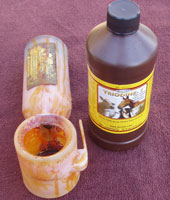
- A dip in strong iodine sterilizes and dessicates what's left of the umbilical
cord, closing off a pathway through which bacteria can find their way into the
lamb. We used to use a 7% solution, no longer available, since it was used by the
meth “industry.” There is now a substitute that provides the same
level of iodine but in a form that can't be misused. The brand we get is called
Triodine-7, pictured here. Your farm store will almost certainly carry
something like this. Do not settle for a product containing only 1% iodine, the
so-called “gentle iodine.” It is too weak for the purpose.
- The dispenser/applicator can be as simple as a pill bottle, a commercial
teat-dipper (shown here), or something you cobble together from PVC pipe fittings.
- Clean rags or towels
-
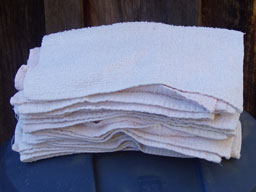 We bought a really cheap package of 50 "automotive" towels from Costco and
dedicated them to sheep use. It would be impossible, of course, to list all their
uses on our farm.
We bought a really cheap package of 50 "automotive" towels from Costco and
dedicated them to sheep use. It would be impossible, of course, to list all their
uses on our farm.
- Pencils, and a small clipboard
-
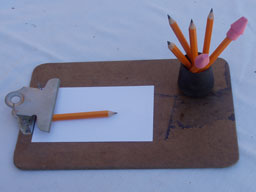 More than one pencil, since they get lost in the hay. Clipboard holds lambing
cards. The more notes you take at birth, the more fun you can have – if you
want to – tracking the history of lambing at your farm.
More than one pencil, since they get lost in the hay. Clipboard holds lambing
cards. The more notes you take at birth, the more fun you can have – if you
want to – tracking the history of lambing at your farm.
- Kitchen garbage bags
- For gathering up cast off placentas and whatever.
Additional supplies to have on hand for problem lambs
- Lamb drench
- Quick-energy nutrient solution for jump-starting a weak lamb so that it will
get up on its feet and go for the bag. Nutri-Drench is widely available.
In recent years we have been very pleased with a product called Baby Lamb
Strength. It is available from
Pipestone,
and perhaps others. The calories in Nutri-Drench come mainly from sugars whereas
the calories in Baby Lamb Strength come mainly from fat.
- Milking jars
- Wide-mouth bottles (6oz jelly/canning jars work well) to catch the milk
when stripping a ewe. Narrow-mouth containers are not good. It is harder than you
would imagine to direct the stream of milk where you want it to go.
- Tube feeder
-
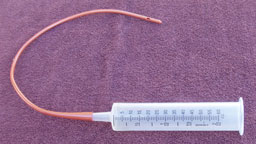 This consists of a large (30cc or 50cc) syringe with a "catheter tip" and a
long rubber tube to be threaded down the lamb's throat to deliver milk directly to
its stomach. This can be, literally, a lifesaver.
This consists of a large (30cc or 50cc) syringe with a "catheter tip" and a
long rubber tube to be threaded down the lamb's throat to deliver milk directly to
its stomach. This can be, literally, a lifesaver.
- Heat lamp
- Plus a long, strong extension cord, and a chain to hang it safely with. Please
use extreme caution with heat lamps, and don't leave them unattended for long
periods. You can kill a lamb with too much heat, and you can burn your barn down
if the lamp gets knocked loose and lands in the bedding.
- Milk replacer
- You may not need this, but good to have on hand in case a ewe dies, fails to
produce milk, or just rejects her lamb. Comes as a powder to be mixed with
water. Widely available from farm stores and by mail order.
- Pritchard teat
-
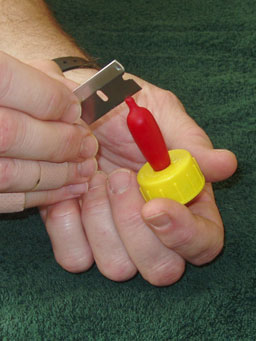 There is really no substitute for this device when bottle-feeding. Other
artificial nipples designed for sheep are just way too big. You may need
to slice the tip with a razor blade, but be very careful to make only the tiniest
opening possible. Slice cross-wise into the teat from the end
rather than cutting it off. You want the slit to close up when the lamb is not
suckling.
There is really no substitute for this device when bottle-feeding. Other
artificial nipples designed for sheep are just way too big. You may need
to slice the tip with a razor blade, but be very careful to make only the tiniest
opening possible. Slice cross-wise into the teat from the end
rather than cutting it off. You want the slit to close up when the lamb is not
suckling.
- Electrolytes
- It is common for a bottle-fed lamb to scour if it gets too much milk replacer
too fast. When this happens, you can dilute the milk replacer with electrolyte
solution. That way you keep the lamb hydrated, but on a less-rich diet until its
digestive system returns to normal.
Top
 If you are expecting more than two or three lambs, and you want to be sure of their
parentage, there is no substitute for an ear tag. Unfortunately, commonly-available
tags are way too heavy for Soay lamb ears. Our long-time source of appropriate tags—Dalton—no longer carries them, so try for rabbit tags or anything you can find that is really small.
If you are expecting more than two or three lambs, and you want to be sure of their
parentage, there is no substitute for an ear tag. Unfortunately, commonly-available
tags are way too heavy for Soay lamb ears. Our long-time source of appropriate tags—Dalton—no longer carries them, so try for rabbit tags or anything you can find that is really small.





 We bought a really cheap package of 50 "automotive" towels from Costco and
dedicated them to sheep use. It would be impossible, of course, to list all their
uses on our farm.
We bought a really cheap package of 50 "automotive" towels from Costco and
dedicated them to sheep use. It would be impossible, of course, to list all their
uses on our farm. More than one pencil, since they get lost in the hay. Clipboard holds lambing
cards. The more notes you take at birth, the more fun you can have – if you
want to – tracking the history of lambing at your farm.
More than one pencil, since they get lost in the hay. Clipboard holds lambing
cards. The more notes you take at birth, the more fun you can have – if you
want to – tracking the history of lambing at your farm. This consists of a large (30cc or 50cc) syringe with a "catheter tip" and a
long rubber tube to be threaded down the lamb's throat to deliver milk directly to
its stomach. This can be, literally, a lifesaver.
This consists of a large (30cc or 50cc) syringe with a "catheter tip" and a
long rubber tube to be threaded down the lamb's throat to deliver milk directly to
its stomach. This can be, literally, a lifesaver. There is really no substitute for this device when bottle-feeding. Other
artificial nipples designed for sheep are just way too big. You may need
to slice the tip with a razor blade, but be very careful to make only the tiniest
opening possible. Slice cross-wise into the teat from the end
rather than cutting it off. You want the slit to close up when the lamb is not
suckling.
There is really no substitute for this device when bottle-feeding. Other
artificial nipples designed for sheep are just way too big. You may need
to slice the tip with a razor blade, but be very careful to make only the tiniest
opening possible. Slice cross-wise into the teat from the end
rather than cutting it off. You want the slit to close up when the lamb is not
suckling.